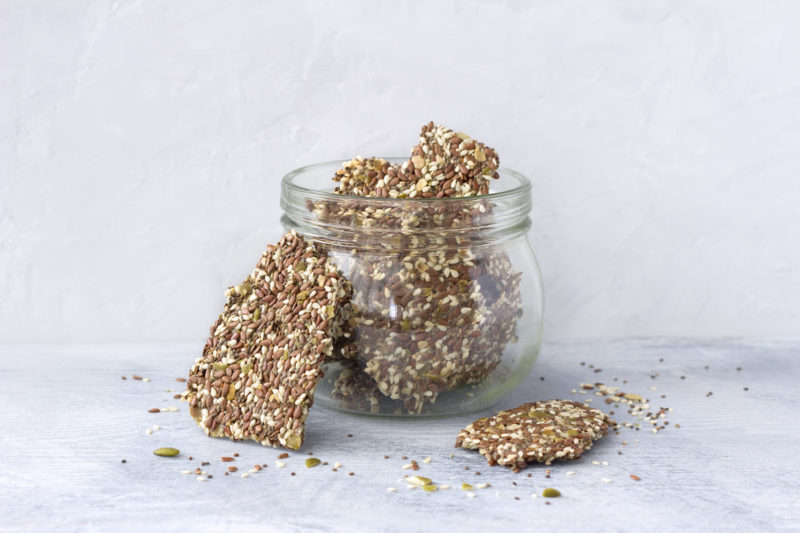Fiber intake is closely tied to metabolic health. And most Americans aren’t eating enough of it. According to the USDA Dietary Guidelines, “More than 90 percent of women and 97 percent of men do not meet recommended intakes for dietary fiber,” in part because more than 85 percent of adults don’t eat enough fruits, vegetables, and whole grains. (Though whether whole grains are a good source of fiber is up for debate—more on that below. In addition, beans, legumes, nuts, and seeds are among the best sources of fiber.) What’s worse, even those official recommendations (less than 30 grams/day) may be lower than we really need for optimal health (which may be 50 grams/day or more).
Fiber is a macronutrient that mostly comes from plants. (Other macronutrients are protein and fat.) Though it is considered a carbohydrate, your body mostly doesn’t break it down into glucose like other carbs; fiber mostly passes intact through the gastrointestinal tract. There, it feeds and maintains the gut microbiome, which has beneficial effects on metabolic health, such as improved glucose and insulin levels. It also keeps gut inflammation down, protects the gut’s mucus membrane, and slows glucose absorption. In his book Fat Chance, Dr. Robert Lustig calls fiber “half of the ‘antidote’ to the obesity pandemic.” (The other half is exercise.)
There are two different types of fiber—soluble and insoluble. Both have unique health benefits, so it’s important to make sure your diet includes both.
Soluble fiber dissolves in water to become a viscous, gel-like substance that’s extremely fermentable (fermentation is the process by which gut microbes break down fiber). Because of this, eating soluble fiber helps maintain good fiber-digesting organisms in the gut microbiome.
Insoluble fiber, which doesn’t dissolve in water, is a bulky substance that’s less fermentable and helps food move through the gastrointestinal tract. Consuming it in high amounts has been linked to lower insulin resistance. Most high-fiber foods contain both types of fiber, and they work together to control the way your body processes glucose. Eating both kinds makes you feel full longer, helping cut cravings for more food.
Here are the primary benefits of fiber and how you can get more of it.
 Want to learn more about how your diet impacts your health?
Want to learn more about how your diet impacts your health?
Levels, the health tech company behind this blog, can help you improve your metabolic health by showing how food—like increased fiber—and lifestyle impact your blood sugar. Get access to the most advanced continuous glucose monitors (CGM), along with an app that offers personalized guidance so you can build healthy, sustainable habits. Click here to learn more about Levels.
Fiber Fuels the Gut
Many of the organisms that make up the gut microbiome (which include bacteria as well as protozoa, fungi, and viruses) feed on fiber. So, when you eat a high-fiber diet, these organisms thrive, helping to maintain a diverse gut microbiome. This has a ripple effect on glucose absorption as well as insulin sensitivity.
Fiber Produces Beneficial Short-Chain Fatty Acids
When gut microorganisms ferment soluble fiber, they produce metabolites called short-chain fatty acids. In recent years, studies have linked higher levels of these molecules with improved insulin sensitivity and weight regulation. There are several theories about the mechanisms at work. One is that short-chain fatty acids are absorbed into the blood, where they circulate and bind cell-surface receptors on tissues in the gut and throughout the body—including white adipose tissue, skeletal muscle, and liver—to influence metabolism and other functions. Doing so is thought to improve insulin sensitivity, but the exact mechanisms are not yet understood.
Butyrate, acetate, and propionate are the major short-chain fatty acids produced when dietary fiber is fermented. Together, they make up 90-95% of the total short-chain fatty acids in the colon.
Although you can get small amounts of butyrate from foods like butter, milk fat, and vegetable oil, most of the butyrate your body uses comes from the fermentation of dietary fiber. Some animal studies have shown that butyrate reduces appetite, alleviates obesity, and may help stimulate pancreatic beta cells to release insulin. Studies have found that people with Type 2 diabetes typically have lower concentrations of butyrate-producing bacteria in their gut compared to people without diabetes.
Propionate is converted into glucose when the body isn’t getting enough from food, a process called gluconeogenesis. Propionate and butyrate also stimulate PYY and GLP-1, two gut hormones that suppress appetite. One small study found that propionate is particularly good at stimulating the release of these hormones, which also reduces the amount of fat the body stores. Acetate has also been shown to stimulate these same hormones and may also play a role in reducing appetite but through a different mechanism.
Another Fiber Benefit: It Keeps Inflammation Down
Fiber keeps inflammation at bay by feeding gut bacteria. Most prebiotics—which feed the microorganisms already in your gut—can be classified as dietary fiber (probiotics, in contrast, add new ones). Prebiotics help maintain the balance between the anti-inflammatory and pro-inflammatory gut microorganisms. Imbalances in the gut microbiota—a condition known as dysbiosis that occurs when some gut microorganisms flourish while others falter—have been linked to gut inflammation and metabolic changes and diseases like obesity, inflammatory bowel disease, and malnutrition.
Diets high in fat and sugar and low in fiber—such as the Western diet—are associated with lower levels of certain beneficial bacteria. Fiber, in contrast, helps keep the gut microbiome in a healthy balance and increases the diversity of the microbiome, including bacteria that promote anti-inflammatory processes. Research from the Finnish Diabetes Prevention Study, for example, showed that people who ate more fiber had higher blood levels of indolepropionic acid, an anti-inflammatory chemical produced by gut bacteria that also regulates blood glucose levels.
In addition, the short-chain fatty acids produced by fiber have anti-inflammatory effects through several different pathways.
Fiber Helps Protect the Gut Lining
Another way fiber keeps inflammation down is by maintaining the gut’s mucus layer, a physical barrier that keeps pathogens out. If the mucus layer is compromised and pathogens can breach it, the immune system mounts an inflammatory response. These pathogens can be invading microorganisms, or they can be those that already exist in the gut.
In a mouse model, reduced dietary fiber intake appears to spur certain human gut microorganisms to start consuming the mucus layer, leaving it and its host susceptible to infection by pathogens and gastrointestinal inflammation. Similarly, mice fed a low-fiber Western diet have been shown to have a more penetrable mucus layer. Early research supports the hypothesis that low-grade inflammation in the mucus layer impairs insulin receptor signaling, driving insulin resistance. Meanwhile, the short-chain fatty acid butyrate has anti-inflammatory properties that support both the health of the intestinal barrier and mucosal immunity.
Learn more:
Fiber Helps Prevent Metabolic Dysfunction
Fiber’s benefits also lie in the fact that it can help blunt post-meal blood sugar spikes. Appetite signaling and the appearance of glucose in the small intestine are primarily triggered by gastric emptying, the movement of partially digested food into the small intestine. Soluble fiber binds liquids to make food more viscous, slowing this movement. Researchers have hypothesized that the reduced rate of gastric emptying after eating fiber causes lower post-meal glucose absorption and decreased appetite (eating viscous food swells the gut, making you feel full).
Diets high in insoluble fibers have also been linked with reduced risk of Type 2 diabetes. One large meta-analysis found that every additional 10g of daily fiber eaten reduced the risk of diabetes by 25%. Several mechanisms likely contribute to this effect. One is the movement of food through the large intestine, known as colonic transit time. This rate determines the amount of nutrition and water available to gut microorganisms and thus plays a role in shaping the gut microbiota. Insoluble fiber also increases the bulking of stool, which reduces the absorption and digestion of macronutrients. In short, insoluble fiber makes food slower and more difficult to digest, which reduces the amount of energy your body extracts from the food.
A meta-analysis of the effects of dietary fiber on Europeans with prediabetes or diabetes found that people who ate more fiber had lower HbA1c (a measure of average blood sugar over three months), fasting plasma glucose, insulin, and insulin resistance. Interestingly, the type of fiber (soluble or insoluble) didn’t seem to matter. Instead, the researchers found the most significant improvements in people who switched their fiber intake from low to moderate (19 grams) to high (35 grams). Eating 35 grams of fiber a day, the authors wrote, could lower the risk of premature mortality by 35% in people with prediabetes or diabetes.
A Low-Fiber Diet May Reflect Other Unhealthy Eating Habits
Not getting enough fiber can indicate other dietary shortcomings such as not eating enough whole foods—a common issue in the processed-food-heavy Western diet. Eating this kind of diet is associated with an increased risk of metabolic conditions like insulin resistance, heart disease, and obesity. And, as mentioned above, unhealthy eating patterns are associated with lower levels of beneficial bacteria that act on fiber.
The good news is that the gut microbiome is malleable, responding to dietary changes within hours of eating. This means that increasing your fiber intake now can rapidly shift your gut microbiome to be better at metabolizing fiber. For example, a healthy diet high in fiber from fruits, beans, and vegetables is associated with a gut microbiome that has more Prevotella, a type of gut bacteria that acts upon fiber to produce short-chain fatty acids.
The bad news is that, in the absence of fiber, there are fewer microorganisms like Prevotella. So, even if you eat fiber occasionally but mostly have a low-fiber diet, you won’t build up a reservoir of Prevotella and will have fewer of these microbes acting upon fiber and producing short-chain fatty acids.

How Much Fiber Should You Eat?
Research suggests our ancestors may have eaten as much as 100 grams of fiber a day. Our modern diet is nowhere near this. The U.S. Department of Agriculture (USDA) recommends consuming 14 grams of fiber per 1,000 calories daily. Because caloric recommendations fluctuate slightly based on age and sex, that means women and older people require less fiber. Depending on age, the adult womens’ daily fiber recommendation ranges from 22 to 28 grams (for calorie intakes ranging from 1,600-2000 calories/day), and for adult males, it ranges from 28 to 34 grams (2,000-2,400 calories/day).
According to the American Diabetes Association, people with prediabetes or diabetes should eat at least the recommended amount of fiber for the general population, taking care to source half of it from whole grains. It notes that some people may benefit from increasing their intake to 50 grams per day, but doing so may cause side effects like gas, bloating, and diarrhea. The American Dietetic Association recommends that 30 to 50 grams per day can promote lower blood sugar. A 2001 study similarly found that people with diabetes who ate 50 grams of naturally occurring fiber a day for six weeks had better lipid and blood glucose profiles than those who ate only 25 grams per day.
What the Levels Experts Recommend:
- Dr. Mark Hyman: 30 to 50 grams a day.
- Dr. Sara Gottfried: “I suggest 35–45 grams of fiber per day but build up slowly. Our ancestors ate much more (>50g), yet the mean in the US is around 14 grams a day.”
- Dr. Rober Lustig: “Gastrointestinal docs say 50 grams a day; USDA says 25 grams a day. Right now, the median consumption is 12 grams a day.”
Is There a Case Against More Fiber?
Some in the paleo and keto diet community have argued that fiber is not essential for health, including maintaining the gut microbiome. They point out that studies on fiber, primarily conducted in animals, have produced conflicting results. This is true, but that doesn’t mean you should eliminate fiber from your diet.
According to Dr. Dom D’Agostino, a keto expert and Levels advisor, fiber is not essential, but it is helpful for an optimal diet. He notes that while prebiotic fiber may help to enhance the microbiome, recent research suggests fermented foods may be a better option for building an optimal gut microbiome.
“The biggest advantage from my perspective is that fiber (and fat) delay gastric absorption in a way that reduces glycemic response and probably insulin, too,” says D’Agostino. “I generally feel that higher insoluble fiber is better than higher soluble fiber, but this may vary. Things like chicory root (inulin) often cause intestinal bloating and should probably be avoided by some [who are sensitive to it]. I personally think fiber is overhyped but still often get quite a bit (>30g). Surprisingly, I feel great off little or no fiber, but there’s just too much data in favor of having it in the diet, in my opinion.”
Dr. Ben Bikman, another Levels advisor, has argued that fiber can play a role in improving metabolic health, but its impacts very much depend on the type of fiber consumed, its source, and your baseline metabolic health.
In his book, Why We Get Sick, Bikman says, “In the end, it’s very likely that fiber improves insulin sensitivity in most people by simply replacing sugars and starches that elicit an insulin response. Importantly, one should scrutinize the source of fiber; it’s dumbfounding, but true, that most fiber supplements have sugar as one of the main ingredients.”
What about fiber’s impact on your digestive system? You may have heard fiber will keep you regular or that it may constipate you. In fact, it can do both. “In general, it will help with constipation,” says functional medicine provider Dr. Ami Kapadia, “but if someone has an imbalanced microbiome, there are cases where it can worsen constipation until underlying imbalances are addressed. Overall, it’s always recommended to add fiber slowly and work with a practitioner to determine the best options and approach.”
How to Get More Fiber in Your Diet
Getting more fiber, like maintaining a low-carb diet, can help lower blood sugar levels. While it may seem like these strategies are mutually exclusive—fiber is a carbohydrate, after all—it is possible to consume fiber as part of a low-carb diet. Here are some of the best sources of fiber:
- Chia: Two tablespoons of chia seeds contain 11 grams of fiber and just 2 grams of carbs.
- Flaxseed: The same amount of ground flaxseed contains barely any carbs and packs almost 4 grams of fiber
- Avocado: A little more than half of a large avocado (100 grams) contains 6.7 grams of fiber and 8.5 grams of carbs.
- Beans and lentils: Navy, lima, small white and yellow beans, and lentils are also high in fiber but lower in carbs than other beans.
Whole Grains: A popular way to get more fiber is to swap refined grains for whole grains like brown rice, but some experts suggest that whole grains are not an optimal fiber source. “I use continuous glucose monitoring to determine response to whole grains,” says Levels advisor Dr. Sara Gottfried. “I use them mostly with athletes. I go big on vegetables, small on fruits and whole grains in most of my patients due to metabolic dysfunction.”
Levels advisor Dr. Molly Maloof says, “Realistically, getting fiber from fruits and vegetables is preferred to whole grains and beans for people with autoimmunity or IBS. I aim for roots and fruits, especially polyphenol-packed raspberries.” And, as Lustig points out in Fat Chance, labels can be misleading: “Foods that list ‘whole grains’ as the second or third ingredient may contain as little as 1 percent,” which is why Lucky Charms can claim to be whole grain, while most definitely not being good for stable glucose.
- Fruit: Whole fruit is generally a good source of fiber as it contains both types of fiber (smoothies lose their insoluble fiber) and according to Lustig, “consuming fruit, despite its fructose content, is not nearly as big a problem because the fructose is for the most part mitigated by the presence of fiber.” Berries, guava, pears, grapefruit, and durian are some of the most fibrous fruits.
- Supplements: Dr. Maloof says, “I love Acacia fiber for its soluble fiber making it a prebiotic, and its ability to help people feel full. It absorbs water helping it to expand and improve satiety. This is one of the best parts of taking a fiber supplement.” For people looking to supplement their fiber intake with common products like Metamucil, beware. Metamucil Orange has 16 grams of added sugar in just two tablespoons! Additionally, getting fiber from whole food sources is the best option because fiber-rich foods often are also rich in phytonutrients, antioxidants, and other healthy compounds.
What Do We Still Need to Know?
In this section, metabolic researcher Dr. Matthew Laye outlines five questions that, once answered, could lead to updated recommendations on fiber intake and our understanding of its importance for metabolic health.
- Does the metabolic health benefit stem from an individual’s fiber consumption or their dietary pattern? Separating out fiber from other healthy eating patterns is challenging—foods that are high in fiber are often unprocessed, whole, real foods also improve metabolic health. We also know that healthy low-carbohydrate, lower-fiber whole-food diets can benefit metabolic health to a similar degree as high-carbohydrate diets higher in fiber; they may even produce a greater reduction in glycemic and insulin levels. More research may show that avoiding processed foods is the most important dietary change and that fiber intake is secondary.
- Is it the microbiome or the physiological consequences of the microbiome that are important for metabolic health? For instance, increased short-chain fatty acids, pH changes, and an increased mucus layer (and more) all improve from dietary fiber, but might there be other ways to get those benefits? As an example, maybe all of the positive benefits are downstream from the short-chain fatty acid effects, and we know that there are other ways to increase short-chain fatty acids, such as exercise, the endocannabinoid system, or a well-formulated ketogenic diet. Whether dietary fiber’s benefits are directly due to the changes in the microbiome or related to the downstream effects of that microbiome is an important unanswered question.
- Do the health benefits of increased fiber depend on your existing microbiome? A related question is whether a specific microbiome composition that includes fiber-responsive microbes is necessary for fiber to be beneficial, given that most of the proposed benefits are tied to the microbiome and gastrointestinal health. Individuals’ microbiomes differ significantly and some researchers have speculated that individuals who have depleted their microbiome of fiber-responsive microbes may not benefit from a diet with a greater fiber content. Such individuals may need probiotic supplementation or reintroduction of these fiber-responsive microbes.
- Do fiber types matter, and if so, which is the best? Soluble and insoluble fiber both have plausible physiological reasons they confer health benefits. However, we don’t know the relative contributions of each for optimal health, and some researchers have suggested the fiber source does not matter. Similarly, soluble fiber from supplements rather than whole foods (which also contain insoluble fiber) seems to have positive effects (as in this meta-analysis of soluble fiber supplementation in people with Type 2 and also in obese individuals). Taken together, this data questions whether insoluble fiber specifically is necessary for some or all of the metabolic health benefits.
- What is an ideal fiber intake amount? Current dietary guidelines are 25g of total fiber per day, while many of the Levels advisors recommend closer to 50g per a day (based on a number of studies showing benefits; here and here). Some papers have shown a plateau effect at 25g and there is also data suggesting that our ancestors had fiber intakes closer to 100g per day (but lacking fiber from grains and legumes). Furthermore, we must also approach these numbers with some skepticism, given that they are likely derived from nutritional epidemiology, an area of research with real limitations in accurately quantifying dietary details. Therefore the point at which diminishing returns for various benefits from dietary fiber exist is unknown, likely related to other lifestyle factors (such as exercise, stress, and immunity), and will require future research.

 Want to learn more about how your diet impacts your health?
Want to learn more about how your diet impacts your health?







